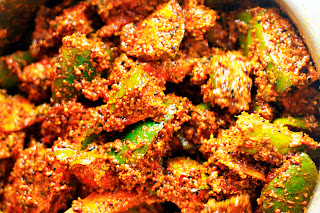#Pickle Season: A Taste of
Tradition and Memories
As the summer
sun reaches its peak, it brings with it the cherished pickle season — a time
that stirs up beautiful memories from my childhood.
Growing up in
the countryside, I remember how my mother would prepare pickles with fresh
mangoes, jackfruit, and green chilies. Our ancestral village would come alive
with activity, especially around my aunt (Bua), who made the most delightful
sweet pickles. My siblings and I would finish them off in no time, much to the
dismay of the elders — especially me, as the eldest, often bearing the brunt of
the scolding.
Those pickles
were more than just food — they were an emotion. The rich aroma, the sharp
tanginess, and the spicy bursts would leave our mouths watering. Back then,
everything was made from scratch. Spices were hand-ground on traditional stone
slabs — a process that demanded effort and care. My mother would spend hours
preparing them, pouring not just her energy into the process, but her love and
warmth too.
Today, the
market is flooded with ready-made spice blends, making the process more
convenient. But nothing compares to the pickles my mother made — and now, my
wife does too. She seems to have inherited my mother’s culinary talent, and her
homemade mango pickle brings back those sweet memories with every bite.
Here’s a
glimpse into her traditional recipe for mango pickle:
- Select Mangoes: Choose 5 kg of Sukul or Malda mangoes, cube or
slice them as desired, and wash them thoroughly. - Sun-Dry: Pat dry
the pieces with a clean cloth and leave them under the sun to dry. - Turmeric Pre-Coating: Rub the slices with turmeric and again leave them
in the sun for 3–4 hours. - Spice Mix: Dry
roast mustard seeds (yellow & black), fenugreek (methi), coriander,
fennel (saunf), cumin (jeera), nigella (mangraila), ajwain, dry red
chilies, and a touch of vinegar in a pan. - Grind Spices: Blend the roasted spices into a fine mix.
- Mix It All: Add the
spice mix to the dried mango slices. - Season Further: Mix in turmeric, salt to taste, saunf (whole), and
chili powder. - Mustard Oil: Heat
500g mustard oil, let it cool, then mix it with the mango-spice blend. Add
a pinch of asafoetida (hing). - Sun-Cure: Transfer
everything to a clean jar, making sure pieces are fully coated. Leave it
in the sun for a week. - Ready to Eat: Once flavors develop, the pickle is ready.
- Storage: Transfer
to a sterilized jar for long-term storage.
A Story of Entrepreneurship
In October
2020, Kalpana Jha and Uma Jha — two enterprising sisters-in-law from Darbhanga,
Bihar — turned this age-old tradition into a successful business. They founded Jhaji
Store, an online platform that offers homemade pickles using authentic
Mithilanchal recipes. Today, their startup boasts a monthly revenue of ₹60
lakhs, proving that our heritage, when preserved with sincerity, can become a
thriving venture.
Pickles are an
inseparable part of Indian cuisine — not just for their taste but for their
cultural and emotional significance. Whether it’s mango, lemon, chili, or mixed
vegetable, every bite tells a story of labor, love, and legacy.
Text &
Photos by: Ashok
Karan
Please like, share, and subscribe. Thank you!
#Hashtags
#PickleSeason #IndianTraditions #HomemadePickles #FoodMemories #MangoPickle
#IndianCuisine #CulinaryHeritage #FamilyRecipes #JhajiStore #MadeWithLove
#Mithilanchal #BiharFood #AshokKaran #FoodEntrepreneurship #TraditionalRecipes





Leave a Reply